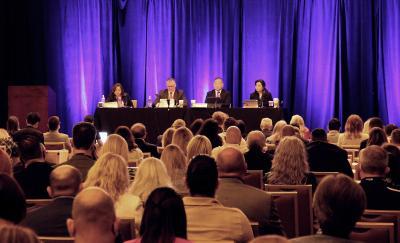The focus was on the future at U.S. Customs and Border Protection’s first Trade Facilitation and Cargo Security Summit. Over 3,000 attendees, 1,000 on-site and more than 2,000 virtually, gathered in Anaheim, California, July 18-20, to learn more about CBP’s forward vision in a constantly changing trade environment. It was the first time CBP had hosted an in-person trade event of this magnitude since the pandemic began two-and-a-half years ago. It was also the first time the agency had combined two of its signature events—CBP’s annual trade symposium and the Customs Trade Partnership Against Terrorism conference, or CTPAT.

CBP Commissioner Chris Magnus welcomes attendees at CBP’s 2022 Trade Facilitation and Cargo Security Summit, held July 18-20, in Anaheim, California. The summit was the first time CBP combined two of its signature events -- CBP’s annual trade symposium and the CTPAT conference. Photo by Eric Hakopian
“I know we have experienced some incredible challenges over the past few years. In fact, even saying, ‘incredible challenges,’ sounds like a gross understatement. Some of these challenges have been driven by the pandemic. Others are a result of global, political, economic, and environmental trends. But they’ve been difficult,” said CBP Commissioner Chris Magnus, who welcomed the hybrid audience from the Hilton Anaheim.
“CBP has not been immune to these challenges,” he continued. “But I think the men and women of our agency have stood firm in their commitment to fulfill our mission.” Magnus noted that the agency receives a lot of media attention about immigration. “I think sometimes what gets lost in the coverage is the incredible humanitarian work our people do,” said Magnus, adding that the humanitarian focus of the agency extends to the trade mission.
“CBP’s trade experts are leading the global fight against forced labor, a practice with more than 25 million victims worldwide. We know forced labor hurts vulnerable workers of all kinds, legitimate businesses and consumers. I am incredibly proud of the work CBP has done to address this issue,” said Magnus. “Over the past year, CBP has issued five new withhold release orders and two findings. So far in this fiscal year 2022, CBP has detained approximately 2,000 shipments worth an estimated $358 million.”
Magnus explained that the significant increase in detentions over the last year was largely due to improvements in how CBP’s trade staff targets shipments. “We’re also constantly evaluating our enforcement posture. Last fiscal year, CBP modified four withhold release orders after the target entities demonstrated that they had fully corrected forced labor conditions,” said Magnus. “This year, CBP has engaged with a record number of foreign entities that are remediating forced labor conditions in their production, which will help improve working and living conditions for thousands and thousands of workers. This is exactly the kind of change we want to see.”

Panelists at CBP’s 2022 Trade Summit explore the topic of forced labor enforcement in a breakout session on July 18, at the Anaheim Hilton. From left, Moderator Elva Muñeton, assistant director of field operations for trade at CBP’s LA Field Office; John Pickel, DHS principal director of trade and economic competitiveness; Eric Choy, CBP acting executive director trade remedy law enforcement; and Sarah Calle, senior international relations officer, Office of Child Labor, Forced Labor & Human Trafficking, U.S. Department of Labor. Photo by Jimmy Ojeda
Magnus also spoke about the implementation of the Uyghur Forced Labor Prevention Act, a law that many in the trade community thought would create problems for the flow of legitimate cargo. “I’m sure you heard or read it was going to be the end of everything when it came to the free flow of goods, but instead, CBP has worked hard to prepare for the June 21st deadline,” said Magnus. “When this went into effect, we published guidance for industry, we held regular calls and meetings with trade partners, we kept Congress up to date with our progress,” said Magnus. “Because of the team’s focus on implementation and partnership with many of you, we’re minimizing disruptions to legitimate cargo while showing the world that forced labor has no place in U.S. supply chains.”








